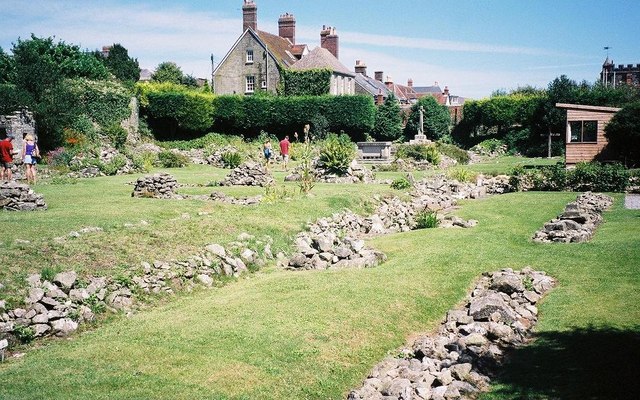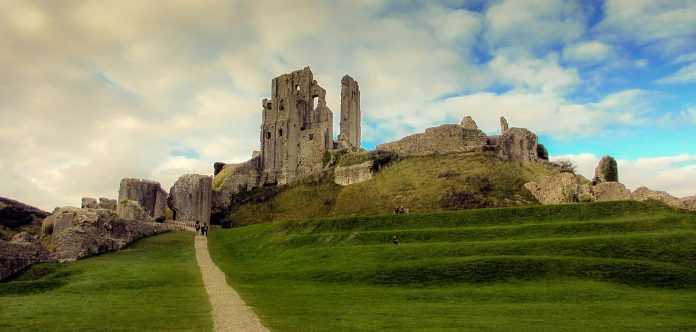Corfe Castle is a historic ruin located in the county of Dorset, on the southern coast of England. This iconic fortress, perched high on a natural hill between the towns of Wareham and Swanage, commands a strategic position that has made it a site of human habitation and fortification for over a thousand years. The castle’s history is intertwined with the turbulent narrative of England itself, encompassing the reigns of powerful monarchs, bloody conflicts, and periods of architectural splendour and destruction. From its early origins as a Saxon stronghold to its dramatic fall during the English Civil War, Corfe Castle is not just a relic of the past, but a symbol of the shifting fortunes of English royalty and aristocracy.
The name ‘Corfe’ is derived from the Old English word ‘ceorfan,’ which means to cut or carve, a reference to the gap in the Purbeck Hills where the castle is situated. This natural gap, through which the main road from Wareham to Swanage still runs, provided a strategic defensive position. The earliest documented evidence of a structure at Corfe dates back to the 9th century during the reign of Alfred the Great, when the site was used as a Saxon stronghold to defend against Viking raids. It is also believed that a Roman road once ran through the gap, further highlighting the site’s long-standing strategic importance.
The castle as we recognise it today began to take shape during the reign of William the Conqueror. After his victory at the Battle of Hastings in 1066, William embarked on a programme of building motte-and-bailey castles across England to consolidate his power. Corfe Castle was one such fortification, and it is thought that the original wooden structure was constructed around 1086. This early version of the castle was built within the earthworks of the older Saxon defences, providing William with a stronghold in a region that was still, in part, resistant to Norman rule.
By the early 12th century, the wooden fortress had been replaced by a formidable stone castle, one of the earliest and most advanced of its kind in England. The construction of the stone keep, with its imposing square tower, marked Corfe Castle as a symbol of Norman authority. The keep was not just a military structure but also a statement of wealth and power. It was built using local Purbeck limestone, giving it a distinct appearance that still impresses visitors today. Under King Henry I, the castle became a royal residence and a treasury, storing valuables and important documents of the realm.
Corfe Castle was also the site of one of the most infamous episodes in medieval English history, the murder of Edward the Martyr. Edward became king in 975, following the death of his father, King Edgar. His reign was short-lived, and in 978 he was assassinated at the gates of Corfe Castle, then a residence of his stepmother, Queen Ælfthryth. The young king was reportedly stabbed in the back while he was drinking wine on horseback, a brutal act that is widely believed to have been orchestrated by Ælfthryth in order to place her own son, Æthelred, on the throne. Edward’s murder turned him into a martyr and a saint, and his body was initially buried without ceremony. His remains were later reinterred at Shaftesbury Abbey, and he became venerated as Saint Edward the Martyr.

The castle continued to play a significant role during the reign of King John, one of England’s most controversial monarchs. King John, often remembered as the villain of the Robin Hood legends, used Corfe Castle as a royal treasure house and a prison. It was here that he kept the Crown Jewels for safekeeping and detained several important prisoners. One of the most notable prisoners was Eleanor of Brittany, the niece of King John, who had a strong claim to the English throne. She was held at Corfe Castle for many years, effectively imprisoned for life, to prevent her becoming a focal point for rebellion against John’s rule.
Corfe Castle’s royal associations continued under John’s son, Henry III, who made extensive modifications and additions to the castle, including the construction of additional towers and walls. These fortifications turned Corfe into one of the most formidable strongholds in England, able to withstand prolonged sieges and assaults. The castle’s location, combined with its formidable defences, made it almost impregnable.
However, despite its strength, Corfe Castle faced significant challenges during the English Civil War in the mid-17th century. The conflict between the Royalists, who supported King Charles I, and the Parliamentarians, who sought to limit his power, tore England apart. Corfe Castle was held for the king by Lady Mary Bankes, the wife of Sir John Bankes, the Attorney General to Charles I. When the war broke out, Sir John was away on royal business, and Lady Bankes found herself in charge of defending the castle against the Parliamentary forces.
In 1643, the Parliamentarians laid siege to Corfe Castle. Despite being vastly outnumbered, Lady Bankes and her small garrison of family members and loyal servants managed to repel the attackers. This remarkable defence earned Lady Bankes the nickname ‘Brave Dame Mary,’ and she became a symbol of loyalty and courage. However, in 1645, the castle fell to the Parliamentarians through an act of treachery. Colonel Pitman, a Parliamentarian commander, disguised some of his soldiers as Royalists, who then gained entry to the castle. Once inside, they opened the gates to the rest of the army. The defenders, caught off guard, were overwhelmed, and Corfe Castle was captured.
Following its capture, the Parliamentarians ordered the castle to be destroyed to prevent it from being used as a military stronghold again. The process of ‘slighting,’ or deliberately destroying a castle’s fortifications, was carried out using gunpowder to blow up parts of the structure. The result was the dramatic ruins that we see today. Huge sections of the walls and towers were brought down, and the once-mighty keep was shattered. The destruction of Corfe Castle marked the end of its role as a military stronghold, but it also preserved the site as a historical ruin, offering a poignant reminder of the Civil War’s destructive impact.
In the centuries that followed, Corfe Castle became a picturesque ruin, its shattered silhouette evoking a romantic image of a bygone era. The castle’s ruins became a popular subject for artists and writers, particularly during the 18th and 19th centuries, when the Romantic movement in art and literature idealised the beauty of decaying structures and the sense of historical melancholy they evoked. J.M.W. Turner, one of England’s greatest landscape painters, depicted the ruins of Corfe Castle in his work, capturing its dramatic setting and the play of light and shadow on its weathered stones.
In 1982, the castle and much of the surrounding village of Corfe Castle were gifted to the National Trust by Ralph Bankes, a descendant of Lady Mary Bankes. The National Trust undertook a programme of conservation to stabilise the ruins and improve access for visitors. Today, Corfe Castle is a major tourist attraction, drawing visitors from all over the world who come to explore its evocative ruins and learn about its rich history. The castle offers a glimpse into the past, with its surviving walls and towers providing clues to its former grandeur and the lives of those who once inhabited it.
Walking through the ruins of Corfe Castle, one can almost feel the weight of history that clings to its stones. The jagged remains of the keep, the massive earthworks, and the surviving fragments of the curtain wall all bear witness to the castle’s turbulent past. From the murder of Edward the Martyr to the heroic defence by Lady Bankes, the castle has been the setting for events that have shaped the course of English history.
Yet, beyond its role in the grand narrative of the nation, Corfe Castle also tells a more personal story; the story of those who lived, worked, and fought within its walls. It was a place of power and splendour, but also of intrigue, betrayal, and violence. The castle’s prison towers remind us of the individuals who were confined within their cold, dark walls, cut off from the world outside. The great hall, now open to the sky, once echoed with the voices of kings, nobles, and servants, going about their daily lives in the shadow of the great keep.
Today, Corfe Castle stands as a monument to resilience and survival. Despite the attempts to destroy it, the castle has endured, its ruins standing defiantly against the elements and the passage of time. The gaps and fractures in its walls are as much a part of its story as the stones themselves, each crack and crevice a testament to the forces, both human and natural, that have shaped it.
The castle’s relationship with the surrounding landscape is also a key part of its identity. The views from the top of the hill are breathtaking, with sweeping vistas across the Purbeck Hills and down to the distant sea. This commanding position, which once made Corfe such a formidable fortress, now offers visitors a chance to appreciate the beauty of the Dorset countryside. The village of Corfe Castle, nestled at the foot of the hill, with its quaint stone cottages and narrow streets, completes the picture, creating a sense of stepping back in time.
As a site of national heritage, Corfe Castle is carefully managed to balance preservation with public access. The National Trust works to ensure that the castle remains safe and accessible, while also protecting its fragile fabric from further decay. This involves a delicate process of conservation, using modern techniques to stabilise the ruins without compromising their historic character. The castle also serves as an educational resource, with exhibitions, guided tours, and interactive displays helping to bring its history to life for visitors of all ages.
In recent years, archaeological investigations have continued to uncover new insights into the castle’s past. Excavations have revealed evidence of earlier structures beneath the Norman stonework, suggesting that the site was occupied long before the castle as we know it was built. These discoveries add new layers to our understanding of Corfe Castle’s long and complex history, showing that it has been a place of human settlement and activity for many centuries.
Corfe Castle’s enduring appeal lies not only in its dramatic ruins and fascinating history but also in its ability to connect us with the past. It is a place where the boundaries between legend and history blur, where the stories of kings and queens, knights and rebels, resonate across the ages. The castle’s ruins are more than just stones and mortar; they are the physical embodiment of the struggles, triumphs, and tragedies that have unfolded within their shadow.
As the sun sets over the Purbeck Hills, casting long shadows across the ruins of Corfe Castle, it is easy to imagine the ghosts of its past inhabitants wandering through the shattered arches and crumbling walls. The castle’s story is far from over; as long as it stands, it will continue to inspire wonder and curiosity in those who visit. Its history, etched into the very stones that have withstood centuries of war, weather, and time, will always be a part of the landscape and a testament to the resilience of those who once called it home.
KEEP US ALIVE and join us in helping to bring reality and decency back by SUBSCRIBING to our Youtube channel: https://www.youtube.com/channel/UCQ1Ll1ylCg8U19AhNl-NoTg AND SUPPORTING US where you can: Award Winning Independent Citizen Media Needs Your Help. PLEASE SUPPORT US FOR JUST £2 A MONTH https://dorseteye.com/donate/







